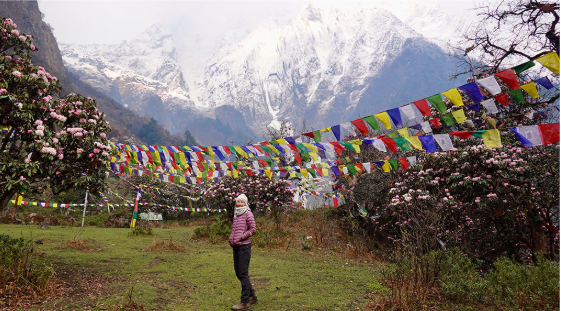Hidden underneath the towering shadows of Nepal’s more extremely popular Everest and Annapurna districts lies a trekker’s paradise—rugged, inaccessible, and luxuriously fulfilling. The Manaslu Circuit trek is not a fair path; it is a trek into the supernatural heart of the Himalayas, circling the world’s eighth-highest mountain, Mount Manaslu (8,163 meters). This off-the-beaten-path trek takes you through socially wealthy towns, perfect valleys, and over the imposing Larkya La Pass, advertising an involvement that feels like time travel through old Tibetan-influenced culture and untouched Himalayan wilderness.
The Manaslu Trek Enterprise is a dream travel destination for those looking for both crude excellence and bona fide social experiences. Not at all like the bustling trails of Everest or Annapurna, Manaslu offers isolation, quietness, and a view that rivals any of Nepal’s head treks. From lavish marshes dabbed with rice porches to tall snow-capped passes encompassed by frosty peaks, each step on this circuit is layered with discovery.
Discovering the Manaslu Circuit Trek
The Manaslu Circuit Trek is a high-altitude enterprise that ordinarily ranges from 14 to 20 days, depending on the course and acclimatization plan. Beginning from the town of Soti Khola or Machha Khola, trekkers continuously climb through subtropical woodlands, cliff-hugging trails, and curious towns like Jagat, Deng, and Namrung. As you move higher, the social texture shifts from Hindu-dominated swamps to the Tibetan-influenced good countries of Samagaon and Samdo.
The centerpiece of the trek is the Larkya La Pass, which is 5,160 meters in height and is one of the most sensational and longest Himalayan passes. The climb to the pass and its all-encompassing summit view—flanked by mountains like Himlung Himal, Cheo Himal, and Annapurna II—is both the trek’s most noteworthy challenge and its designated wonder. The plunge leads you into the Annapurna locale, inevitably connecting to Dharapani and the Marsyangdi Valley.
Manaslu’s offer lies in its untainted scenes, uncommon natural life (including blue sheep and the slippery snow panther), old cloisters, and the crude genuineness of life that beats through each settlement. It’s a travel that feels otherworldly, physically demanding, and candidly enhancing all at once.
Manaslu Circuit trek cost:

One of the most inquired questions around the Manaslu Circuit trek is: How much does it take a toll? The toll of this enterprise shifts based on variables like trek length, guide and watchman administrations, type of convenience, licenses, and whether you book through a Local or international agency.
Here’s a breakdown of what you can ordinarily expect:
- Grants (Per Person):
Manaslu Limited Range Allow: USD 100 for the to begin with 7 days (Sept–Nov), USD 15/day from that point; USD 75 for the to begin with 7 days (Dec–Aug), USD 10/day thereafter.
Annapurna Conservation Area Project (MCAP): USD 30
Annapurna Conservation Area Project (ACAP): USD 30
TIMS Card: Not required for Manaslu Circuit, but other zones might require it if combined.
- Guide and Porter:
Hiring a government-licensed guide is obligatory in the limited region. Their expenses extend from USD 30 to 40 per day. A watchman, who carries up to 20–25 kg, more often than not charges USD 20 to 30 per day. Numerous trekkers enlist a combined guide-porter for a decreased expense, more often than not around USD 30 per day.
- Convenience and Meals:
Teahouse trekking is the standard on the Manaslu Circuit. Fundamental lodges offer twin-sharing rooms with shared lavatories. The cost per night ranges from USD 10 to 15, and dinners take a toll around USD 10 to 15 per dish, resulting in almost USD 35–45 per day.
- Transport:
Getting to the trailhead includes a bumpy but picturesque jeep or transport ride to Soti Khola or Machha Khola. A private jeep costs around USD 200–250 (one-way), whereas a nearby transport is around USD 15–20 per person.
- Miscellaneous:
Add costs for charging gadgets, Wi-Fi (where accessible), hot showers, and snacks—approximately USD 10 –15 per day extra.
Estimated Add up to Taken a toll (per person):
Budget trek (with shared guide and fundamental teahouses): USD 900 – 1,100
Mid-range trek (with private guide, watchman, and guide consultation): USD 1,200 – 1,600
Luxury trek (with all courses of action dealt with, private transport, and additional comforts): USD 1,800 – 2,500
Booking with a neighborhood office in Nepal regularly offers superior value for money than international administrators, and bolsters the local economy responsibly.
What Makes the Manaslu Circuit Unique?

Unlike other well-known trekking courses, the Manaslu Circuit remains less commercialized. The path grants, as it were, a restricted number of trekkers due to its limited range status. This control gets to jam the region’s social keenness and environmental adjustment. Here’s what makes this circuit stand out:
Authentic Culture: The Tsum and Nubri valleys are domestic to ethnic Tibetans, where you’ll witness old cloisters, Mani dividers, chortens, and supplication banners rippling in the mountain breeze.
Fewer Swarms: You won’t be competing for space in teahouses or evading expansive trekking groups. The quietness of the path makes it perfect for immersive experiences.
Challenging Pass: The Larkya La Pass is a physical and mental test, offering a significant sense of accomplishment.
Diverse Landscape: The path moves from sticky timberlands and waterfalls to fruitless mountain scenes and ice sheet views.
Day-by-Day itinerary of the Manaslu Circuit trek (20 Days)
Here’s a normal schedule that includes equalization, enterprise, acclimatization, and exploration:
Day 01: Arrive in Kathmandu (1335 meters).
Day 02: Sightseeing and Trek Preparation.
Day 03: Drive to Barpak village (1915 meters).
Day 04: Trek to Laprak (2100 meters).
Day 05:Trek to Khorla Besi (970 meters).
Day 06: Trek to Philim. (1570 meters).
Day 07:Trek to Bihi Phedi. (1990 meters)
Day 08:Trek to Serang Gumba (3042 meters).
Day 09: Trek to Ghap (2160 meters).
Day 10: Trek to Lho. (3180 meters.
Day 11:Trek to Sama Gaon. (3525 meters)
Day 12:Acclimatization Day at Sama Gaon.
Day 13: Trek to Samdo. (3860 meters).
Day 14:Acclimatization Day at Samdo.
Day 15: Trek to Dharmasala. (4460 meters)
Day 16: Cross Larke La (5106 meters) and trek to Bimthang. (3610 meters)
Day 17: Trek to Dharapani (1960 meters).
Day 18: After breakfast, drive to Kathmandu via Besisahar.
Day 19: Free day in Kathmandu, stay overnight in Kathmandu.
Day 20: Departure.
This trek permits for slow rise pick up and numerous acclimatization days, lessening the hazard of elevation sickness and improving your capacity to appreciate the high-altitude environment.
Best Time to Do the Manaslu Circuit
The Best time to trek Manaslu Circuit is harvest time (September to November) and spring (March to May). Amid these periods, the skies are regularly clear, temperatures are guide, and mountain sees are sharp and vibrant.
Autumn is the most well-known, advertising a steady climate and wealthy social merriments like Dashain and Tihar in nearby villages.
Spring brings rhododendron blossoms and somewhat hotter temperatures—perfect for photography and nature lovers.
Physical and Mental Preparation
Although not a specialized climb, the Manaslu Circuit trek requires great wellness, stamina, and mental flexibility. Long strolling hours, tall height, and inaccessible conditions challenge even prepared trekkers. Preparing with cardio, quality conditioning, and multi-day climbs, some time recently, your trek is highly recommended.
Make beyond any mistake to consult your specialist about elevation-related afflictions like Diamox, and continuously listen to your body as you rise. Acclimatization and hydration are key to a fruitful trek.
Packing List for the Manaslu Circuit Trek
Here’s a condensed list of fundamental things you’ll need:
Clothing: Moisture-wicking base layers, protection layers (fleece/down), waterproof shell, trekking pants, warm clothing, gloves, cap, and buff.
Footwear: Broken-in trekking boots, sandals/camp shoes, and warm socks.
Gear: Resting pack (appraised for -10°C or lower), trekking shafts, headlamp, water purification tablets, shades, and rucksack with rain cover.
Toiletries & Wellbeing: Sunscreen, lip demulcent, to begin with, help pack, elevation pharmaceutical, latrine paper, and sanitizer.
Miscellaneous: Snacks, control bank, camera, travel reports, and cash (ATMs are nonexistent on the trail).
Why Select the Manaslu Circuit Over Other Treks?
If you’re somebody who pines for an honest-to-goodness association with nature and culture, the Manaslu Circuit ought to be at the best of your list. Not at all like the Everest or Annapurna treks, this path rewards those willing to go the additional mile with peace, magnificence, and realness. You’ll share minutes with local people, sit in the shadows of towering peaks, and cross paths with individual explorers who esteem isolation over selfies.
This trek too offers extraordinary adaptability for side trips—like Manaslu Base Camp or expanding to the Tsum Valley, which has its own sacred Buddhist points of interest and Himalayan lore.
Conclusion:
The Manaslu Circuit trek is not a fair trek—it’s a transformational encounter. As you follow the strides of dealers, friars, and old caravans, you’re also following your own individual travel of continuance, investigation, and inward peace. Whether you’re drawn by the charm of the Larkya La Pass, the sacrosanct chants reverberating from a good country cloister, or the fulfillment of surviving 17 days in the inaccessible mountains, Manaslu offers an uncommon kind of magic.
In a world that’s moving as quickly, Manaslu reminds us to walk gradually, breathe profoundly, and tune in to the pulse of the Himalayas.
FAQs
- How troublesome is the Manaslu Circuit Trek?
Moderately to exceedingly challenging, primarily due to long days, tall elevations, and the Larkya La Pass. Great wellness is necessary.
- Is the trek secure for solo travelers?
Solo trekking is not permitted in the Manaslu locale. An enrolled guide is required, guaranteeing security and social insight.
- Can apprentices do the Manaslu Circuit Trek?
While not suggested for supreme tenderfoots, fit trekkers with earlier multi-day climb experience can complete the trek with legitimate acclimatization.
- Do I require travel insurance?
Yes, travel protections that cover high-altitude trekking and crisis clearing are essential.
- What are the resting and nourishment choices on the trail?
Teahouses offer fundamental rooms and generous Nepali suppers like dal bhat, noodles, and momos. Most are clean but exceptionally simple.
If you’re prepared to exchange swarms for realness and selfies for soul-searching, at that point pack your boots and step into the Manaslu Circuit Adventure—a trip into the exceptionally heart of the Himalayas.
Booking Process for Manaslu Circuit Trek with Visit Himalaya Treks
To book the Manaslu Circuit Trek through Visit Himalaya Treks, begin by contacting them via email or WhatsApp to discuss your preferred dates, group size, and specific needs. VHT will provide a detailed itinerary covering the duration of the Manaslu Larke Pass Trek, highlights, costs, and inclusions such as a guide, porter, meals, accommodation, and transportation.
We, Visit Himalaya Treks, will finalize all logistical arrangements, including transportation, accommodation, and permits, to ensure everything is in place for your trek. Upon arrival in Nepal, the team will ensure that all aspects of the trek are organized, providing you with a smooth and unforgettable experience on the trek to Manaslu Circuit, visiting the Base Camp of Mount Manaslu. Our company specializes in pure off-the-beaten-path destinations like the Kanchenjunga Base Camp Trek in eastern Nepal, one of the most beautiful treks in Nepal. Similarly mesmerizing Mount Makalu Base Camp Trek or any other Himalaya Trekking Tours in Nepal.
